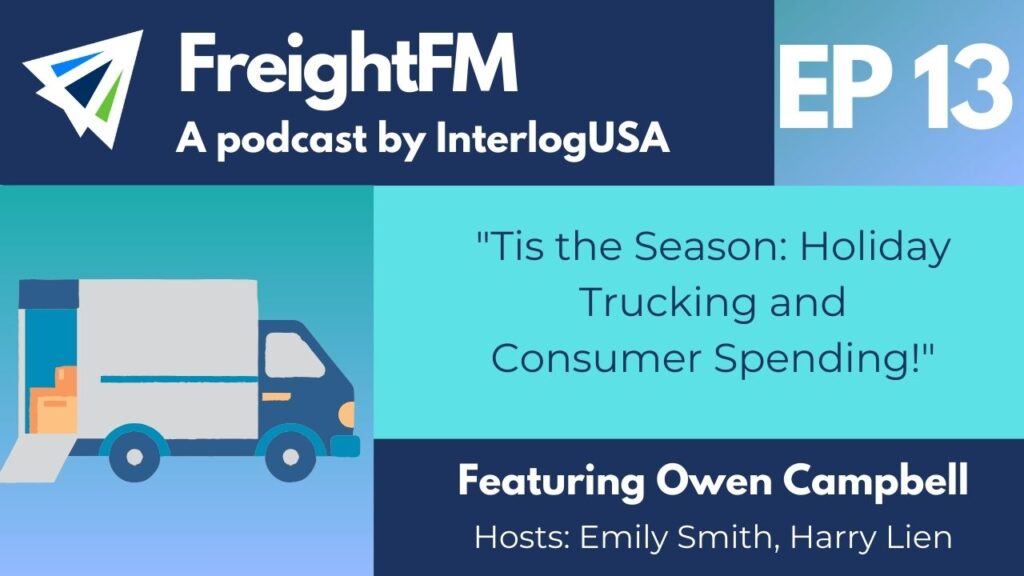
November 2023
The following is an archived collection of our weekly insights through the month of November. Those who had signed up to our Interlog Insights newsletter received each week’s update to their inbox on the original release date. If you like what you see below, please feel free to sign up yourself to get these updates right as they come!
This month's insights
- Panama Canal Crisis
- Holiday Consumer Spending
- Routing via Suez Canal
- Dry Bulk
Week 3 - Originally released November 17
Insight: Agriculture Exports Seek Solace Via Suez Canal Routing
In last week’s edition of Interlog Insights, the advantages of U.S. East Coast-bound routings via the Suez Canal were surfaced.
While this choice in transit, which sends cargo sailing in the opposite world direction, has always been practical for U.S. shippers who import from Southeast Asia and India, the ongoing crisis at the Panama Canal has invited the intrigue of others—including U.S. agriculture exporters who urgently desire to send their product to their Far East and China consumers.
For the record, drought-related restrictions at the Panama Canal have rightly concerned all sectors of oceangoing transportation. Most attention has been placed on higher-capacity interests, like container or natural gas shipping, however the sector which is responsible for the carriage of U.S. agricultural (ag) exports—dry bulk—has also felt the heat of the canal’s deteriorated state.
Through the green-tinted lens of profit, ag exports are basically the “ugly stepsister” of more lucrative trades, like the gold standard of American imports from Asia. Outbound mounds of bulk ag products, like grain and seed, are not as economically inspiring as the vibrant container mosaics on inbound megaships.
Dry bulk vessels carry high volume, low value, loads to overseas markets. While this isn’t to understate dry bulk’s value to global trade, from the perspective of an import-heavy U.S., there seems to be little chatter about the sector’s respective struggles with the Panama Canal.
Dry bulk executives confirm the routing change
As importers calculate strategies to mitigate the canal’s impacts on container shipping, ag export patterns have already seen a compelling shift. A majority of dry bulk vessels are now rerouting to China and other Asian markets through the Suez Canal.
Specifically, grain exports out of the Gulf Coast to Asia, typically routed through the Panama Canal, have been at the heart of this movement. While a shift to the Suez Canal adds about ten days of transit and added expenses through canal dues, bulk carriers have embraced this adaptive strategy.
During a November 3 conference call, reported by FreightWaves, a bulk carrier executive confirmed: “Particularly for grain cargoes out of the U.S. Gulf to China and Asia, [the Panama Canal route] is the typical trade historically…We’re now routing our ships through the Suez.”
Real-time ship data from tracking providers, like MarineTraffic, support this. A major trend can be observed of dry bulk ships carrying U.S. grain routing through the Atlantic and the Mediterranean Sea, while ultimately transiting the Suez Canal on their way to Asian destination ports.
These vessels each have a capacity of 90,000 deadweight tons (DWT) or less.
DWT is a metric used for bulk vessel capacity as opposed to containerships which measure capacity by number of twenty-foot units, or containers.
Rocky times for ag exports
The overall state of U.S. ag exports has been rocky this year. If a drought on the Panama Canal wasn’t bad enough, for a second straight year, the Mississippi River has also been compromised to low water levels. The river is a central artery that links Midwest farms with the Gulf Coast.
Low water levels translate to tightened capacity and higher rates for river barges, the preferred mode ag exporters use to bring product from farms to ports of loading.
Unlike the Panama Canal, the Mississippi River has shown signs of recovery, however the river’s conditions earlier this fall prompted many shippers to opt for costlier rail transits.
Shipper Hotline: Industry Question and Answer
Have a question about international shipping and logistics? Email our team at support@interlogusa.com
We’ll get back to you right away and may feature your question (anonymously) on our next edition of Interlog Insights!
Insight: What are Consumers Spending on this Holiday Season?
Last week we talked about when consumers are planning to start and finish their holiday shopping. This week we are discussing what consumers are planning to spend on during the holidays. As well as ways consumers may be ‘cutting back’ on spending in other areas in order to cover holiday spending costs.
For this upcoming holiday season, it’s anticipated that consumers will spend $620 dollars on gifts, while $255 will come from spending on gifts and seasonal items.
As the National Retail Federation has reported, the most popular way to shop this year is online. Followed by in person at department, discount, and clothing stores, small businesses, electronic stores, craft and fabric stores, outlets, and lastly, thrift stores.
There continues to be conversations in the past few months and ongoing, on what impact the economy has on holiday spending this year.
Of course, the question can be asked if consumers are taking additional measures to help cover the costs of holiday spending, which could include but not limited to cutting back in other areas, waiting till thanksgiving weekend sales, or others.
The main consensus is consumers are planning to cut back in other areas in a way to help cover holiday spending. Working overtime or taking on additional hours is a very close second, for both age groups.
Of these options, taking out additional credit cards is the least likely to be used option.
Graphs above are courtesy of the National Retail Federation.
Week 2 - Originally released November 10
Insight: Sourcing Shift to Southeast Asia and India taps Suez Canal
In a changeup which includes Western Mexico’s Port of Lázaro Cárdenas capturing regular calls from ocean carriers, service alternatives to work around the Panama Canal’s ongoing draft and transit limitations are in full swing.
As covered the other week, a historic drought has deteriorated conditions at the Panama Canal, the waterway which links the Pacific Ocean with the Atlantic Ocean. This issue, which has shown signs of worsening, has disrupted traditional Asia-East and Gulf coasts routings. Vessel weight limits have forced lighter loadings and a capacity crunch. Carriers have passed on container surcharges onto shipper-customers.
Aside from stops in Mexico, importers who have shifted their sourcing have benefited from another transit altogether—one which bypasses the embattled Panama Canal by turning inbound routings from Asia, completely westbound.
Westbound routings from Asia via the Suez Canal
To be clear, this bold maneuver doesn’t exude practicality for U.S. shippers who import from China, but rather a growing number of importers who have shifted their sourcing to Southeast Asia and the Indian Subcontinent.
In recent years, these two regions of Asia have seen an increase in shares of lucrative U.S. containerized imports. Make no mistake, China still dominates the sphere, accounting for nearly half of all U.S. inbound trade from Asia, but the writing is on the wall—shippers are diversifying their supply chains.
As a result, carriers have taken notice. Capacities are strategically allocated to accommodate Southeast Asia and India routings to the U.S.—a westbound transit which utilizes another world-renowned waterway, the Suez Canal.
Now, this westbound service isn’t a product of the Panama Canal’s current dry spell, however the associated disruptions have certainly empowered East Coast importers who ship from Southeast Asia and India to embrace this strategic routing.
Unlike its drought-struck contemporary, the Suez Canal has no immediate concerns over volatile water levels and subsequent limitations. The waterway, operated by the Egyptian government, regularly sees Europe-bound vessels with Middle East oil exports. However, it is perfectly capable of assuming a facilitator role for East Coast containerized trade.
Ships loaded with 23,000 twenty-foot-equivalent unit (TEU) capacity can pass through the canal. This bandwidth actually surpasses the Panama Canal, which handles ships up to 15,000 TEU capacity.
Even before the Panama Canal’s restrictions, U.S. East Coast routings via Suez from India West Coast ports, like Nhava Sheva and Mundra, were already common practice. However, the sourcing shift in Southeast Asia and India has prompted even more shippers to pursue this pathway to bring their overseas cargo in.
Insight: When are Consumers Planning on Spending to Start and Stop Shopping for the Holidays?
Whether you like to get your holiday shopping done early or you’re someone who likes to live on the edge a little and deal with holiday shopping closer to the actual holidays. In this week for insights, we take a look at when consumers plan to start and stop shopping for the holidays.
When are consumers planning to start their shopping this year?
41 percent of consumers are planning to start their shopping in October or earlier
39 percent of consumers are planning to start their shopping in November
9 percent of consumers are planning to start their shopping in December
When are consumers planning to finish their shopping this year?
16 percent of consumers are planning to finish their shopping by October or earlier (impressive!)
26 percent of consumers are planning to finish their shopping by November
58 percent of consumers are planning to finish their shopping by December
Black Friday and Cyber Monday holidays are the ever so popular shopping days during Thanksgiving weekend. Just last year alone, 196.7 million consumers shopped throughout the Thanksgiving holiday weekend, per data from the National Retail Federation.
Check out our other content!
Pay a visit to our website for a closer look at other InterlogUSA content, including recordings of past webinars, podcasts, and blogs. Also, follow InterlogUSA LinkedIn and Facebook pages for even more updates and content!
Week 1 - Originally released November 3
Insight: Mexican Port Rises as an Alternative to the Embattled Panama Canal
The Panama Canal will be a buzzword when describing container shipping in 2023.
The manmade 51-mile waterway is pure transportation ingenuity. The canal cuts across the Isthmus of Panama, effectively connecting the Pacific Ocean with the Atlantic Ocean. This shortcut saves containerships from what used to be a harrowing transit around the entire South American continent.
The Panama Canal is credited for making direct westbound transits from Asia economically viable for U.S. East and Gulf coast shippers.
However, the canal’s revolutionary contributions to trade will be overshadowed this year by a spell of misfortune.
Instead, supply chain professionals will recall the Panama Canal’s ongoing drought and the subsequent disruptions caused by its historic severity.
Canal conditions have shown no signs of recovery, expected to linger into 2024
Earlier this summer, industry stakeholders began to express concerns over a severe drought affecting the Panama Canal.
Canal authorities implemented aggressive water-saving measures on nearby lakes which feed the canal with freshwater. They’ve also investigated building more reservoirs from surrounding rivers to address the scarcity of this resource.
At the same time, the canal has had to impose draft restrictions for ships as water levels continued to fall. In return, ocean carriers are placing load restrictions on their vessels, translating to higher transportation costs and container surcharges for shipper-customers.
While these woes at the Panama Canal will forever be associated with the state of container shipping in 2023, the drought-related restrictions are likely to persist into 2024, according to canal authorities.
The Panama Canal Authority has already announced extended restrictions which bleed into the new year—just 18 ships a day will be allowed to sail through the waterway in February 2024.
In normal (non-drought) conditions, typically 35 to 40 vessels are permitted to pass each day through the Panama Canal. It’s clear that the industry has a trade black hole, one that’s apparently compounding day by day.
Port of Lázaro Cárdenas draws carrier calls
Perhaps accredited to learned-savvy needed during pandemic-era shipping, the industry has devised an alternative to work around the Panama Canal, the traditional and preferred way of navigating between the East and Gulf coasts and Asia.
The Western Mexico Port of Lázaro Cárdenas has attracted a fair share of regular and ad hoc (when necessary) calls from ocean carriers to bypass the canal’s restrictions and limits.
Lázaro Cárdenas, the second-busiest container port in Mexico, is already a well-acquainted stop for carrier services between Asia and the South America West Coast, as well as two-way routes between South America and the U.S. West Coast. However, its presence with transpacific imports into the U.S. is usually minimal, if nonexistent.
However, the circumstances with the canal have changed this. The Mexican port is now in the loop, quite literally.
With the first arrival scheduled November 9, carrier Zim Integrated Shipping has added Lázaro Cárdenas as a direct call on its Baltimore Express (ZXB), a service which connects Southeast Asia and China with the East Coast.
CMA CGM has also included the Mexican port into its call list on services. In many cases, the carrier has used it as a stop to unload some containers to make a good weight before entering the Panama Canal.
Hapag-Lloyd has announced that it’ll use Lázaro Cárdenas as an intermodal gateway to the East Coast, as well as inland destinations, like Dallas, Kansas City, Chicago, and Laredo. The carrier has made an agreement with Canadian Pacific Kansas City (CPKC), a Class I railroad already active with building an intermodal service portfolio at the port.
CPKC may benefit from the Panama Canal’s tribulation. When April’s merger between Canadian Pacific and Kansas City Southern finally materialized, the networks of these two Class I railroads became one. One that is looking to expand its service offerings across the U.S., Canada, and Mexico. With uncertainty over the canal’s status heading into 2024, this just may be the audition CPKC needs.
This isn’t the first time Lázaro Cárdenas has been used as a safety valve. During the pandemic-era height of container shortages and delays in Southern California, some importers resorted to the Mexican port. They trucked their freight from the port up to railway Kansas City Southern’s (now CPKC) ramp in Texas.
Considering how poor conditions were at U.S. ports, transit times with this alternative service were often competitive.
NEW Podcast: Holiday Trucking and Consumer Spending!
Hosts Emily Smith and Harry Lien are joined by Interlog’s trucking guru Owen Campbell to discuss consumer spending and trucking conditions ahead of the uncertain holiday season!
Insight: Winter Holidays 2023 - How Much Are Consumers Expected to Spend?
Fresh off of Halloween, we enter a new set of holidays – the winter holidays. This year the National Retail Federation is predicting consumers to spend around $875 on average on gifts, decorations, food and other key seasonal items.
The graph above (courtesy of the NRF) shows the growth of holiday spending during November-December from years 2002 to 2022, plus the forecast for 2023.
As you can see in the graph, every year since 2009 has seen an increase from the previous year. According to the NRF data, that will be no different this year.
So how does this year line up to last year?
Data shows retail sales during November-December last year totaling $936.3 billion, which was a 5.3 percent increase from 2021.
This year – the NRF is predicting total retail sales (during that same time period) to be between $957.3 billion and $966.6 billion, which would be an increase of 3 to 4 percent.
On an individual standpoint, the NRF expects that $875 amount predicted this year, to be more than $42 from the year prior.
What did you think?
In addition, please email us at support@interlogusa.com with any news or topics you’d like our experts to cover in future issues!


